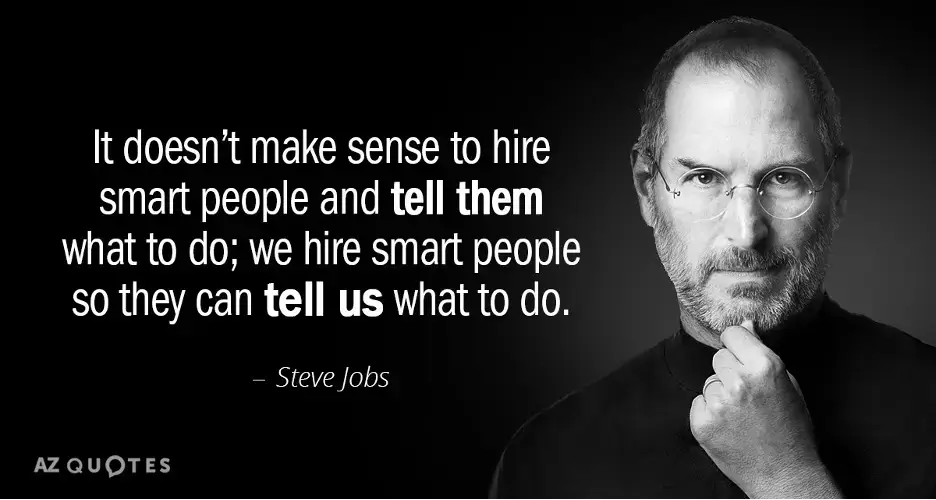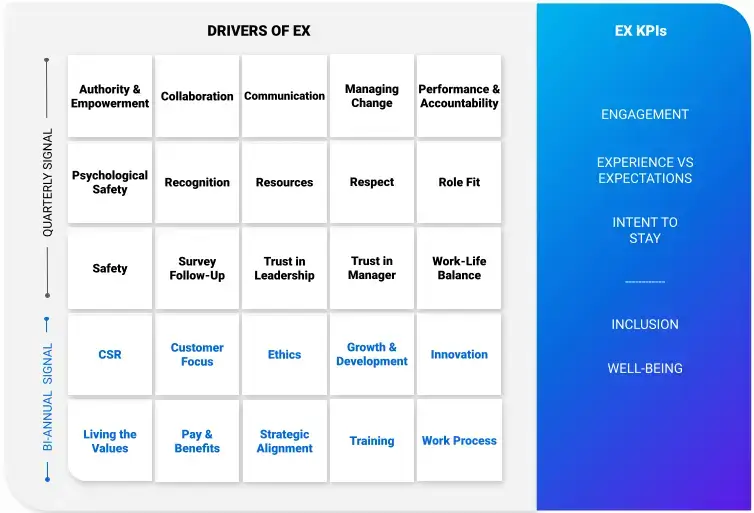
Employee Experience
Psychological safety in the workplace
When employees feel safe to challenge the status quo, they bring new, innovative ideas to the table. But without psychological safety at work, your employees won’t speak up – and your organization will suffer the consequences. What is psychological safety, and why does it matter to your organization?
In this article, we’ll take a closer look at what psychological safety looks like in the workplace, with examples; why supporting psychological safety in the workplace matters; and our advice for creating a psychologically safe work environment.
The world is just coming out of a pandemic. A hybrid-first work climate. A global recession. Worries about AI. All these major disruptors have had a marked impact on how we forge the necessary connections to feel safe at work, and hence our psychological safety.
In such an environment of uncertainty, do your employees feel safe to voice an unconventional or even an unpopular opinion in the workplace? Can they share their ideas freely in a brainstorming session? Or, do they fear going against the grain – or worse, being ridiculed by their colleagues or peers?
The level to which your employees feel safe contributing is important, not only for their sense of belonging, engagement, and inclusion, but also for the organization's ability to manage the ongoing change and disruption.
Diversity of thought – and challenging the status quo – brings about new, innovative ideas. But without an environment where employees feel safe and welcome to speak up, your business will suffer.
Free eBook: Learn to create a culture of well-being
What is psychological safety?
Psychological safety is the notion of feeling able to speak freely – and with conviction. It’s characteristic of an environment where managers encourage team members to be their best, and it not only helps employees feel like their voices matter, but also drives organizations forward.
The construct of psychological safety was coined by Amy Edmondson, a Harvard Business School professor, who defined it as ‘a shared belief held by members of a team that the team is safe for interpersonal risk taking’.
Watch Professor Edmondson explaining how the concept of psychological safety came to her, and how to use it to build a psychologically safe workplace:
At work, employees feel psychologically safe when they can not only share their ideas (such as in a brainstorming session) or challenge the status quo, but also when they know that their peers, colleagues, and leaders will not punish or humiliate them for speaking up with questions, ideas, concerns or mistakes.
Psychological safety at work occurs when employees feel a sense of belonging; when they’re able to bring their whole, authentic selves to the workplace and feel free to share their unique thoughts, feelings, ideas, questions, and mistakes without worrying they’ll be judged or made to feel inferior because of their contributions.
What are the stages of psychological safety at work?
Getting to a place of feeling psychologically safe at work takes time. Dr. Timothy Clark, Founder, and CEO of LeaderFactor and five-time author, details the four stages employees progress through in his book, The 4 Stages of Psychological Safety: Defining the Path to Inclusion and Innovation.
According to Dr. Clark, the four stages of psychological safety at work are:
Stage 1: Inclusion safety
Inclusion safety satisfies the basic human need to connect and belong. In this stage, you feel safe to be yourself and are accepted for who you are, including your unique attributes and defining characteristics.
Stage 2: Learner safety
Learner safety satisfies the need to learn and grow. In this stage, you feel safe to exchange in the learning process, by asking questions, giving and receiving feedback, experimenting, and making mistakes.
Stage 3: Contributor safety
Contributor safety satisfies the need to make a difference. You feel safe to use your skills and abilities to make a meaningful contribution.
Stage 4: Challenger safety
Challenger safety satisfies the need to make things better. You feel safe to speak up and challenge the status quo when you think there’s an opportunity to change or improve.
The benefits of psychological safety
Only when employees progress through these stages of psychological safety will they feel safe, secure, recognized and empowered, to make valuable contributions and challenge the status quo.
Safe, happy teams create great business and people outcomes. They:
- take more calculated risks
- feel free to create and innovate
- flag up problems sooner
- are more resilient in the face of change and external challenges
- are likely to stay longer with the company
You’ll notice improvements to engagement, workplace culture, creativity and innovation, well-being, attrition rate, performance, brand advocacy and sentiment.
And, most importantly, when you empower and support employees, they go above and beyond to deliver better customer experiences, leading to customer loyalty, increased revenues and brand equity.
At Qualtrics, we measure psychological safety with our EX25 solution, by asking the following questions:
- I can share my opinions openly without fear of retaliation
- My manager values my perspective, even if it is different from their own
- Senior leadership values diverse perspectives, even if they are different from their own
- In my team, it feels safe to take social risks (e.g., asking questions, making mistakes, highlighting problems)
According to research by Josh Bersin, companies that take a holistic approach, prioritizing the physical and psychological safety of employees are:
- 2 times more likely to exceed financial targets
- 8 times more likely to adapt well to change
- 2 times more likely to retain employees
- Likely to see dramatic drops in absenteeism and health insurance claims
So, by making sure your employees are psychologically safe, this has a knock-on effect to every other experience.
Examples of psychological safety in the workplace
Now that you know what it takes for employees to feel safe speaking up and making valuable contributions at work, it’s critical to foster psychological safety in your organizational culture.
Here are some examples of what team psychological safety in the workplace can look like:
- Employees feeling that it's okay to fail and learn, as well as feeling safe to ask for help. This is supported by a learn-it-all, not know-it-all culture
- A company culture that employs data, not necessarily seniority, to enable decision-making
- Employees openly giving and receiving feedback
- A company culture that fosters a sense of belonging, where employees can bring their full selves to work
- Employees feeling safe to speak up when they’re at, or approaching, capacity; to take time off and fully log off when not working
- Employees challenging the status quo when they see opportunities to change or improve the way things are done
How to create psychological safety in the workplace
At its core, creating a psychologically safe workplace isn’t rocket science - it’s founded on good business management practices, such as:
- resourcing your people with the best tools and technology
- establishing clear norms, values and expectations to ensure predictability and fairness
- encouraging open communication
- actively listening to employees
- making sure team members feel supported
- showing appreciation and humility when people speak up and contribute
Ready to get started creating a culture of psychological safety for your employees? Here are our seven steps to help you with building psychological safety at work and developing high-performing teams.
1. Get the tech experience right
As we saw above, bad processes and inefficient systems at best give a poor employee experience, and at worst, cause burnout. When employees have a good technology experience, they have a good work experience. It’s simple, right?
Actually, it’s more complicated than that just now. Today, people are more wary of technology than ever. With the relentless march of AI, many are afraid that the robots are going to take their jobs, replace them and make them redundant.
The challenge for organizations is to get the message across that technology will include and empower employees, rather than exclude them. They must take a ‘people first’ approach and ask:
- How can these new tech solutions help our workforce operate more efficiently and collaboratively?
- How can these solutions free up time for employees to focus on what matters most (whether that’s themselves or a new project)?
Certain technologies, like enhanced employee experience solutions, can offer a safe platform for employees to voice their opinion and know their concerns are met. If their not, managers can see this through their team ratings and create a course of action for improvement.
2. Frame the task as a learning exercise
With any new team project, there is uncertainty ahead, and interdependence on the team. Nobody has done this exact same task before. Nobody knows exactly what is going to happen. Therefore, everybody’s brain and voice will be needed. There’s your rationale for team members speaking up.
3. Lead with bravery (and vulnerability)
Many organizations still defer towards rigid, patriarchal, top-down decision-making that feels safe. (Hint: It isn’t, and it’s only becoming less so.)
It takes individual bravery to express one’s full, authentic self at work. But the burden to be brave shouldn’t sit with your team. The onus should be on the organization to create a psychologically safe space that makes it easy for employees to bring more of themselves to the conference table. This demands both bravery and vulnerability at the senior leadership level.
Managers who lead with bravery and vulnerability will help employees work in a psychologically safe environment.It may be a bit unconventional but bravery often times is. You can do this by:
Acknowledging your own fallibility
As Steve Jobs famously said, “It doesn't make sense to hire smart people and then tell them what to do; we hire smart people so they can tell us what to do.”

Image credit: www.azquotes.com
One way to show bravery as a leader is to invite broad input into decision-making. Own the fact that you don’t know everything. Simply say to your team when discussing a project, “‘I may have missed things, so I need to hear from you”. Address this to all team members, thereby creating an inclusive, psychologically safe environment to speak up.
Modeling curiosity
You want your team to be able to question everything. Question everything yourself by demonstrating curiosity, by asking lots of questions - including the simplest and most obvious. There’s absolutely, categorically, no such thing as a dumb question.
Establishing clear norms and expectations
This may seem like a given, however many teams struggle with understanding their exact expectations and roles. Its important to be brave and build a team on a foundation of trust and transparency.
4.Talk about the importance of psychological safety at work.
Encourage people leaders to talk to their employees about what it takes to foster a culture of psychological safety of team members.
Ask employees what they think a psychologically safe workplace is. Arrive at agreed-to best practices.
5. Be transparent about failures and wins
Normalize talking about what works and what doesn’t at your organization.
Make employees feel safe sharing their wins and their failures, so that everyone can learn from those experiences. Show the value in failing and talk about what to do differently next time in an empowering and productive way.
6. Encourage open dialogue and new ideas - and act on them
Your employees have new and innovative ideas as to how to make things better – whether it’s a simple process improvement or a new product or solution.
Give them the opportunity to share their ideas openly; provide a forum to do so, as well as the encouragement and knowledge that their contributions are welcome, no matter how different they are.
And - most importantly - make sure to act on their suggestions. This is not just about giving people a forum to speak up, it is making sure they can put their suggestions into practice.
7. Ask employees for feedback about psychological safety at work – and take action on that feedback
Dr Amy Edmondson advises, “Don’t assume people will tell you what they’re thinking or that they understand that you want their input. “Explicitly request it,” She suggests asking open-ended questions such as:
- What are you seeing?
- What are your thoughts on this?
- Where do you stand on this idea?
And to better understand if your employees feel included and safe – especially to learn, contribute, and challenge the status quo – simply ask them. Employee listening tools help you quickly and nimbly get a pulse on how your employees feel at work.
Then, once you’ve gathered insights about your workplace culture, take action on the feedback your employees have shared.
Communicate the changes you’re making to improve psychological safety based on their feedback – this helps employees feel heard and that you value their opinions.
How Qualtrics EX25 can help with psychological safety
Because psychological safety is an intrinsic part of the holistic employee experience, it makes sense to measure it as one of its drivers.
EX25 is an industry-leading holistic approach to measuring and optimizing employee experience. EX25 has five KPIs that cover all aspects of the employee experience: engagement, experience vs expectations, intent to stay, inclusion and well-being. We found 25 drivers that affect these KPIs and are essential to the employee experience. As shown in the image below, psychological safety is a key dimension to measure and improve to create a positive employee experience.

When you use EX25, you’ll holistically understand employee experience and where to focus to drive impact and boost team performance, without adding more complexity to your employee listening program.
You’ll understand how your employees rate their psychological safety, within the context of their wider employee experience.
Your people are your biggest asset. Give them a psychologically safe environment to contribute in and show you value their voices. This way, you’ll also harness their purpose, passion, energy, and creativity to meet the challenges you and your organization face.
Free eBook: Improve employee psychological safety with a culture of wellbeing